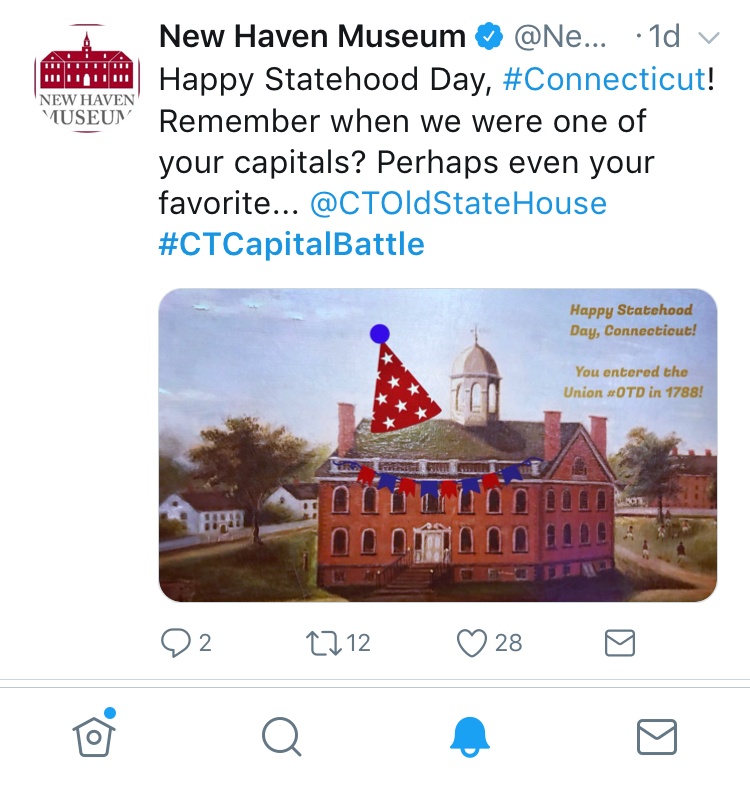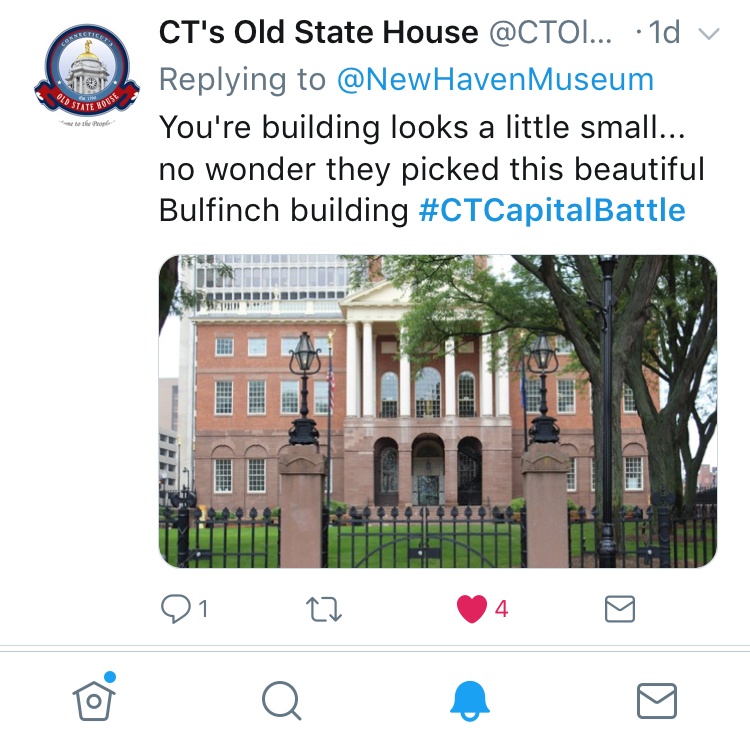
It started with a Tweet. It ended with a semi-Hamiltonian battle. But in the middle there was the question: who actually lays claim to Connecticut's capital? And who should?
On Tuesday, Connecticut turned 230 years old, entering the Union as the fifth state in 1788. Several state politicians, historians, and Nutmeg enthusiasts took to social media to send out some version of "Happy Birthday, Connecticut!" Even Gov. Dan Malloy, in between looking at a new ban on gun bump stocks and displaced Puerto Rican families, tweeted out "Happy #StatehoodDay #Connecticut!," ending the post with a waving American flag.
But in that stream of well-wishers, people seemed to forget that for 174 years New Haven was a co-capital of Connecticut. Except this author and Nicole Sousa, social media specialist at the Connecticut's Old State House (OSH) in Hartford. We decided we wanted to have a Twitter conversation about the history of the capitol buildings and the capital cities. Because how else will people find out what that history is?

To begin, the NHM snapped a close-up picture of the second state house featured in the painting “A View of the New Haven Green in 1800.” We doctored it a bit for fun, and posted it to social media, commenting that New Haven may have been CT’s favorite capital, with the tag #CTCapitalBattle and the gauntlet was thrown down.
Sousa picked it up, the beginning of a four-hour history battle with commentary from history-minded people and organizations, including the Noah Webster House (“he” tried to mediate the issue), along with people who like to learn about history, architecture, art, and community.
Why should you care #CTCaptialBattle when it’s 2018 and New Haven is no longer a capital city? Several reasons. First, think about it. New Haven was founded in 1638 and a significantly sized colony that stretched from Guildford, down to present-day Greenwich, and even included a portion of Long Island. It was a power house (and still is, really) that was a competitor of the Connecticut Colony. Second, we failed to get our charter from the King of England (we had some boat issues). Since we didn’t have the piece of paper that the CT Colony had, towns in our colony began to join the other one. Eventually, we held-out until 1665 before joining Connecticut. Third, thanks to lobbying efforts, by 1701 the legislature established New Haven as co-capital.
Our first “state house” on the Green is seen on the Wadsworth Map of 1748 in the top right corner (Elm and College Streets) where the court house was located. The second state house (1763-4) on the Green was situated where Trinity Church stands today. Finally, our last one was designed by our very own Ithiel Town, and constructed in 1837 in Greek Revival style. But where is it today? Take a walk behind Center Church, mid-way up and to the left. You’ll be standing on the site. In the 1860s there was talk about how it was too expensive and tedious to maintain two state houses and having to travel each October to New Haven and each April to Hartford, and a committee found that there could be only one, but which?

One source claims that a group of state politicians did everything in their power to see that New Haven lost out on any major projects because they felt one of their own lost favor in an election. Who knows if that’s true. What is true is that a public vote via a referendum. The City of Hartford secured a nice piece of land for the new Capitol and emerged victorious in 1873. So why don’t we have the state house on the Green today? It was at one point even the home of the Museum that began yesterday’s debate. It was a beautiful building and can be seen in paintings, drawings, and even photographs. However, it was neglected after 1875 and began to fall down, becoming so hazardous that the City of New Haven had it demolished in 1885 with a few thousand witnesses. As usual, there’s more to the story, but in a nut(meg) shell, the Green is missing a significant landmark demonstrating a tangible political role our great city once played in Connecticut.
Maybe we we lost the #CTCapitalBattle. But we’ve still got our history.
Amy Durbin is the Director of Education & Visitor Experience at the New Haven Museum, enticing people throughout Connecticut and around the world to better know the past in order to change the future. Special thanks also to Nicole Sousa, Social Media Specialist at CT’s Old State House.